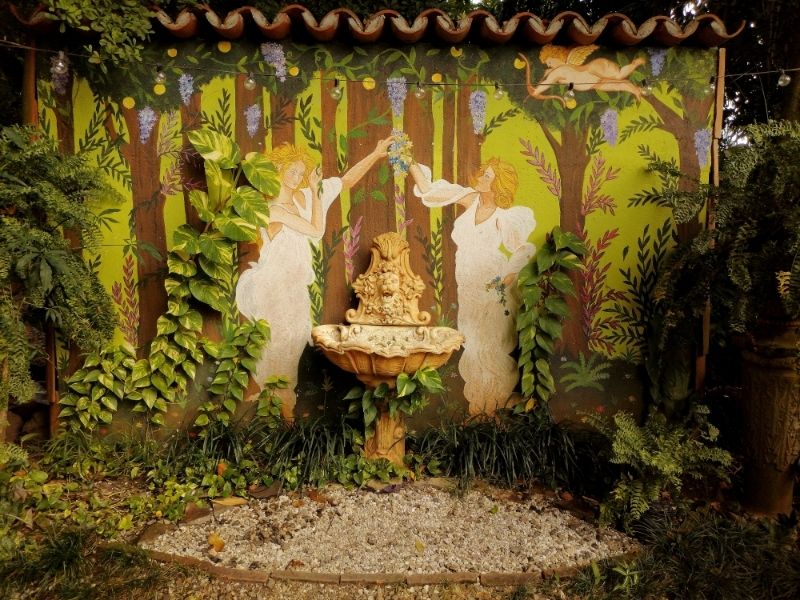Artificial plant walls, also known as green walls or living walls, have become increasingly popular in recent years. They are made up of a variety of artificial plants arranged in a way that creates a lush and verdant wall. These walls have numerous applications and are used in a variety of settings. In this article, we will discuss the different ways in which people use and install artificial plant walls.

Where are artificial plant walls being used?
Artificial plant walls are a versatile and attractive addition to both residential and commercial spaces. They can be used for decorative purposes and practical purposes such as privacy screens and noise reduction.
1. Decorative purposes:
A. Use in residential spaces:
Living rooms: Artificial plant walls are used as a decorative element to bring a touch of nature inside. They add texture, color, and a sense of vitality to the space.
Bedrooms: Artificial plant walls can create a relaxing and calming environment in bedrooms. They add a touch of color to the room and can help reduce stress levels.
Bathrooms: Bathrooms can often feel sterile and clinical. Artificial plant walls can add a natural and create a spa-like atmosphere.

B. Use in commercial spaces:
Office decor: Artificial plant walls are also used in offices and other commercial spaces. They can be used to create a natural ambiance that can help improve the mood and productivity of employees. Artificial plant walls are an excellent way to add greenery to an office without requiring any maintenance or upkeep.
Event decor: Artificial plant walls are a popular choice for event decor. They are used to create backdrops for photos, as well as to divide event spaces. They are an excellent option for outdoor events, as they can help create a natural atmosphere in any setting.
Retail displays: Retail stores often use artificial plant walls to create attractive displays. They can be used to highlight products and create a calming atmosphere that encourages customers to stay longer and browse more products.
Restaurants: Artificial plant walls are used to create a natural and inviting atmosphere. They can also help create a sense of privacy for diners.

2. Functional purposes:
A. Privacy screens:
Use in outdoor spaces: Artificial plant walls can be used as privacy screens on patios, balconies, and outdoor living areas. They provide a natural and attractive alternative to traditional privacy screens.
Use in indoor spaces: In indoor spaces, artificial plant walls can be used to create private areas or block out unwanted views.
B. Noise reduction:
Use in offices: Artificial plant walls can help absorb sound and reduce noise levels in busy office environments.
Use in hotels: In hotels, artificial plant walls can be used to create a more peaceful and relaxing atmosphere for guests.
Use in hospitals: Hospitals can be noisy and stressful environments. Artificial plant walls can help create a calming atmosphere for patients and staff. They can also be used to create private areas within hospital spaces.
How to Install Artificial Plant Walls?
Artificial plant walls can be made up of various types of artificial plants, including foliage, flowers, and succulents. They can be installed on virtually any surface, such as walls, fences, and even ceilings. Below are the basic steps to follow:

Choose the right location: Before you start installing your artificial plant wall, you’ll need to choose the correct location. Consider factors such as lighting, temperature, humidity, and the overall aesthetic of the space. Ideally, you want a spot that is not exposed to direct sunlight for long periods, as this can cause the plants to fade over time. You’ll also want to ensure the surface you plan to install the wall on is clean and debris-free.
Measure the space: Measure the space where you plan to install the wall so you know how many panels you’ll need. Artificial plant walls typically come in panels that are easy to install and can be arranged in various patterns and configurations. Measure the height and width of the space to get an accurate estimate of how many panels you’ll need.
Install the panels: Once you have your panels, it’s time to start installing them. Start at the bottom of the wall and work your way up, making sure each panel is level as you go. You can attach the panels to the wall using a variety of methods, such as screws, nails, or adhesives. Be sure to follow the manufacturer’s instructions for the specific type of panel you’re using.

Arrange the plants: Once the panels are in place, it’s time to arrange the plants. Depending on the type of panel you’re using, you may be able to simply insert the plants into the panel or attach them using wire or zip ties. Be sure to arrange the plants in a natural and realistic way, and don’t be afraid to mix and match different types of plants to create a more varied and exciting look.
Add finishing touches: Finally, add any finishing touches you like, such as decorative elements like rocks or branches or lighting to highlight certain areas of the wall. You may also want to add a drip tray at the bottom of the wall to catch any excess water or debris.
Artificial plant walls are popular for both decorative and functional purposes. They are easy to install. They provide a natural and appealing aesthetic while also serving various purposes in residential and commercial spaces.


